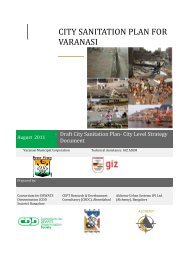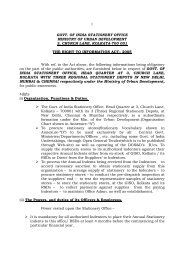CITY SANITATION PLAN - Ministry of Urban Development
CITY SANITATION PLAN - Ministry of Urban Development
CITY SANITATION PLAN - Ministry of Urban Development
Create successful ePaper yourself
Turn your PDF publications into a flip-book with our unique Google optimized e-Paper software.
Sewerage System and Solid Waste Management in slum areas:<br />
<strong>CITY</strong> <strong>SANITATION</strong> <strong>PLAN</strong> BAREILLY<br />
In most <strong>of</strong> the slums, sewerage system is either non-existent or it is found chocked. The problem <strong>of</strong><br />
blocked sewerage also exists in the slums where people stay in pucca houses. The open drains in the<br />
slums are <strong>of</strong> very small size and are mostly blocked due to lack <strong>of</strong> cleaning and solid waste finding its<br />
way into drains. There is no proper way <strong>of</strong> solid waste disposal which exists at the slum level. In 30% <strong>of</strong><br />
the slums solid waste is collected by govt. or private persons but disposal sites are either non-existent or<br />
are poorly managed. In many slums solid waste can be seen flowing in the drains leading to chocked<br />
drains and health hazardous situation.<br />
Key issues:<br />
As per the DUDA and NNB, total notified slums in Bareilly are 85. The current slum population is<br />
about 2.44 lakh with about 32000 <strong>of</strong> households i.e. about 26% <strong>of</strong> the total population.<br />
Majority <strong>of</strong> households i.e. more than 51 percent live in Kutcha Houses made <strong>of</strong> grass, mud etc. and<br />
jhuggi jhopri’s. Only 21 percent stay in Pucca Houses. In slums, about 47 percent have their own<br />
houses whereas 41% lives in as tenant whereas rest is living as unauthorized occupants.<br />
It may be seen that in slums access to individual water connections is low and people generally use<br />
public stand posts, hand pumps, or wells in a few cases. Majority <strong>of</strong> households (55%) get water<br />
from public stand posts and only 19% percent have individual taps.<br />
It has been observed that main source <strong>of</strong> water supply in slum areas is hand pumps and wherever<br />
piped water supply is there, either supply is inadequate or it’s not regular or it’s very dirty.<br />
Lack <strong>of</strong> proper shelter, poor access to basic needs and lack <strong>of</strong> awareness make the slum dwellers life<br />
style very poor. About 25 percent <strong>of</strong> the Bareilly’s population is living in slums; hence all housing<br />
programmes should target provision <strong>of</strong> better shelter for them on priority basis.<br />
In many <strong>of</strong> the slums water through public stand posts and hand pumps have been provided but it<br />
has been observed that lots <strong>of</strong> water is wasted.<br />
Only in a few slums sewerage lines have been provided and they were <strong>of</strong>ten chocked.<br />
ADMINISTRATIVE STAFF COLLEGE OF INDIA, HYDERABAD Page 34
















